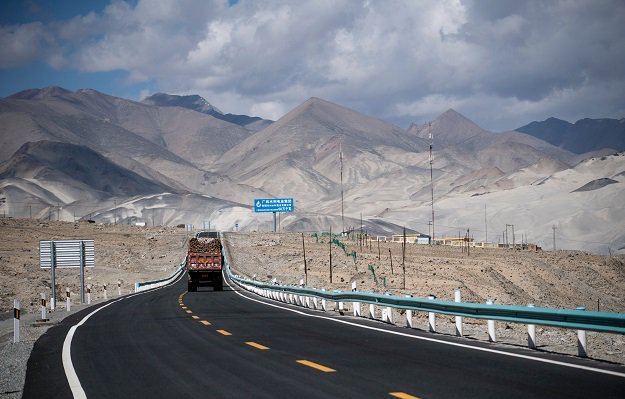
In this emerging dynamics of a post-globalisation world, China is the adhesive that is resuscitating ancient trade routes, including more countries and regions, honing each country’s comparative advantage, promoting mutual interests, and setting an example for cooperation.
Joseph Nye’s concept of ‘soft power’ is most applicable to China today – winning hearts and minds, people and communities through an interwoven route, the Silk Road. Pakistan has embraced the historic Initiative wholeheartedly. The China-Pakistan Economic Corridor (CPEC) is an unprecedented package of co-operation and development.
It is reshaping the geo-economic landscape and will prove to be a game-changer not only for Pakistan but the entire region. Never have investments through a bilateral cooperation framework been done with such speed and effectiveness.
Central and South Asia: Big nations in tussle to develop long economic corridors
Pakistan’s industrial sector
CPEC provides the industrial sector of Pakistan with an opportunity to modernise and become more efficient and competitive. Various energy projects, coupled with improvements in infrastructure and road networks, would help address some of the key constraints to growth.
More importantly, the development of Special Economic Zones (SEZs) would enable industries to smoothen supply chains, enhance collaboration and innovation capabilities, and help reap significant economies of scale.
However, this process will take time to materialise, and the nature of its trajectory would depend, at least in a short to medium term, on two main factors: 1. how the industrial transformation currently under way in China creates potential opportunities for Pakistan; and (2) how prepared Pakistan’s economy is to take advantage of this opportunity.
Industrial transformation in China
After experiencing rapid economic growth over the last three decades, China has been moving towards a new phase of development. The overall policy direction for this transformation stems from the 13th five-year plan (2016-2020), which was adopted by the Chinese government in March 2016.
The plan acts as a guiding principle to all ministries, industries and local governments in formulating their policy goals and development initiatives to complement this new growth paradigm.
The path for industrial modernisation, meanwhile, draws its inspiration from ‘Made in China 2025’ – a master plan adopted in May 2015 to turn China into one of the most competitive manufacturing powerhouses. The objectives are multi-fold, with a focus on emerging and existing industries as well as on quality improvement and brand development. To summarise:
- a) It aims to accelerate the development of new manufacturing and information technologies. Increased focus on provision of services, meanwhile, highlights another departure from the traditional industrial structure, and would require concentrated research and innovation efforts.
- b) On parallel terms, there is a comprehensive roadmap designed to transform and upgrade existing Chinese industries with a clear objective of moving away from mass production of low-end products towards narrow-based, specialised commodities.
- c) By narrowing production and focusing on luxury and specialised commodities, the industries would be trading economies of scale for higher marginal returns. Moreover, concentrating on value addition would give a boost to the process of brand development that China is striving for in order to break into the high-end market. Lastly, this change of strategy would aid in addressing the overcapacity problems that some industries (such as steel and coal) are experiencing at the moment.
- d) Furthermore, the plan highlights the importance of a reduction in the level of dependence on foreign industries for raw materials, services and other products. The plan sets targets to overcome such dependencies. For instance, it advises to increase the share of domestically produced core components and materials to 40% in 2020 and to 75% beyond that.
- e) Finally, the ‘one child’ policy in China has meant that parents have investment significantly in the education of their children. Consequently, there are very limited number of new Chinese entrants in labour intensive industry, causing relocation of such industries into youth rich countries such as Pakistan.
All this would result in a concentrated, specialised and vertically integrated industrial sector that would prioritise application of technology and brand development in order to achieve competitive advantage in high-end and smart manufacturing.
Mergers and acquisitions would be encouraged where certain inefficient firms still show potential; meanwhile, segments of the sector deemed either technologically out-of-date or incompatible with the new growth model would face liquidations, technology transfers and relocations in order to achieve ‘better asset utilisation’.
On the economic front, these advancements are being supported by three major changes that have started to affect the Chinese economy: a shift from investment fueled growth towards consumption-orientation; increased focus on technological enhancement; and a struggle to bring forth the ‘Green Revolution’.
How to maximise returns from these opportunities?
Pakistan not only has an edge over possible competitors when it comes to attracting technology transfers due to geographical proximity and a policy of strategic alliance, but with CPEC an actualising step towards the OBOR initiative, it also shows closer compatibility with China’s new growth model.
Furthermore, the ongoing construction of numerous coal-based power plants throughout Pakistan to ensure consistent electricity provision and the establishment of special task forces to protect CPEC-related ventures are reducing the major binding constraints to growth and FDI inflows.
Pakistan is arterial to Asia, South Asia and Central Asia
Efforts are also needed to align the objectives of federal and provincial government bodies in order to ensure a consistent and comprehensive support policy. The example at hand is the investment policy, which is now a provincial matter after the 18th Amendment, whereas the federal government is leading all industrial initiatives under the CPEC.
Dr M Amanullah is chief economist and Muhammad Usman Khan is an adviser in the Planning and Development Department, Punjab
Published in The Express Tribune, February 19th, 2018.
Like Business on Facebook, follow @TribuneBiz on Twitter to stay informed and join in the conversation.
1730854420-0/plaqueboymax-(1)1730854420-0-405x300.webp)


1729080111-0/BeFunky-collage-(63)1729080111-0-165x106.webp)
1730838202-0/Trump-(1)1730838202-0-165x106.webp)












COMMENTS (1)
Comments are moderated and generally will be posted if they are on-topic and not abusive.
For more information, please see our Comments FAQ